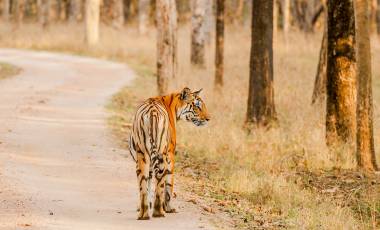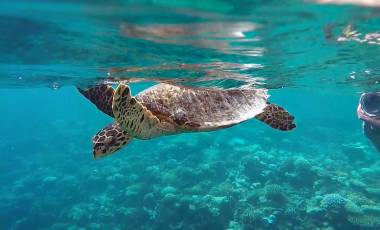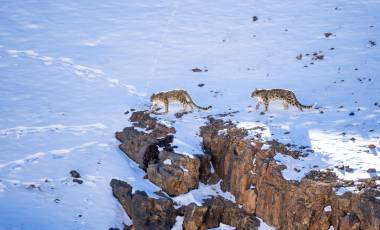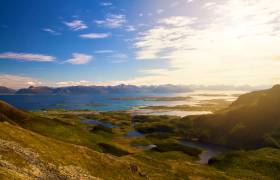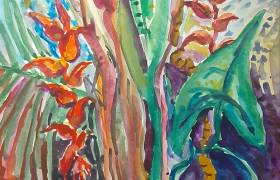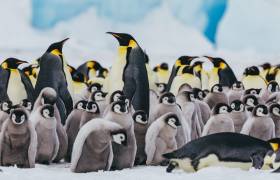Nothing can compare to that moment when you spot a signature species in the wild. Those hair-raising, heart-pumping moments will undoubtedly stay with you for a lifetime – and our expertly guided wildlife trips are designed to heighten your chances of viewing some of the world’s most incredible creatures. When you travel at the beginning of the year from January to March, many destinations are experiencing their dry season, which means plenty of interesting wildlife can be seen congregating around watering holes. Here are six fascinating animals to look out for on our wildlife trips.

1. Bengal tigers, India
Around 70% of the world’s Bengal tiger population is found in India, so if you’re looking to spot these creatures in the wild heading to India offers incredible opportunities for safaris. In the months of January, February and March, India is experiencing its dry season, which means there’s thinner vegetation and undergrowth, so your views of Bengal tigers are less obstructed on safari. Cooler temperatures at the beginning of the year make it more comfortable for Bengal tigers to move around during the afternoons when safaris happen. January and February are also peak months in the tiger mating season, which encourages them to be more vocal and roam across larger areas in search of females – which means there are even more opportunities to spot them.
Our 16-day India Tiger Safari takes you on an incredible journey across Pench, Kanha, and Bandhavgarh National Parks to track the elusive Bengal tiger. Our expert naturalists and experienced wildlife trackers will take you out on 15 different game drives, which helps maximise your chances of spotting these magnificent creatures as they move through open grasslands and forests. En route, you may also get the chance to see leopards, sloth bears and other exciting wildlife.

2. Leopards, Sri Lanka
If you want to increase your chances of spotting leopards in Sri Lanka, we’d recommend booking a trip in January, February or March. This is because these months fall in the dry season in many parts of Sri Lanka, including Yala National Park, which is known to have one of the highest densities of leopards in the world. During this time, there’s minimal rainfall, which encourages leopards to spend more time around the park’s waterholes, making them easier for the park rangers to track. Unlike the wet season, where leopards generally hide to avoid the monsoons, the drier, sunnier weather, means that leopards spend their time resting on tree branches and lying in the sun, which ultimately makes them easier to spot this time of year. The lovely weather also allows for smoother safari experiences, where your 4×4 vehicles can access more parts of Yala, that may have been blocked due to mud caused by monsoons.
On our Wild Sri Lanka trip, you’ll embark on four exhilarating game drives in Yala and Udawalawe National Park to spot leopards, elephants, water buffalos and crocodiles. If you travel during the beginning of the year, your trip will also coincide with peak whale-watching season, where migration patterns take large pods of whales through the waters off the southern coast of Sri Lanka. Our Wild Sri Lanka trip takes you on a whale-watching excursion off the coast of Galle, where you may see sperm whales, Bryde’s whales and even the mighty blue whale if you’re lucky.
On our Discover Sri Lanka adventure, you’ll also get to head out on a 4×4 drive through Yala National Park, while taking in the cultural delights of the country, with trips to the Temple of the Tooth, Sigiriya Rock and Dambulla’s sacred cave temples. If you’re looking to explore by day and relax by night in the comfort of our premium accommodations, our Sri Lanka Wonders & Wildlife Premium Adventure takes you on two safari drives through Yala while staying in boutique hotels and wild glamping lodges. During these safaris, our groups head away from the busy Block 1 in Yala National Park to explore the lesser-visited Block 5. This part of the park sees significantly lower volumes of vehicles which means less crowding around wildlife-rich spots, which ultimately helps to enhance your overall safari experience.

3. Dolphins, Maldives
The months of January, February and March fall in the dry season in the Maldives, and during this time there are excellent opportunities to go dolphin watching. So, if you’re planning a trip to the Maldives at the beginning of 2025, you can expect clear skies, minimal rainfall and calm seas, which makes it easier to spot pods of dolphins.
These months also coincide with the Northeast Monsoon, which typically brings clearer water from the Bay of Bengal, meaning there’s less sediment and plankton in the water, making it easier to view dolphins from a distance. Clear waters this time of year also make for better snorkelling excursions, where you can not only see dolphins but also manta rays, eels and schools of tropical fish. Due to the lack of plankton, spinner and bottlenose dolphins tend to gather around reef edges and atolls to find food, and are often spotted in large pods, much to the delight of travellers on dolphin-watching excursions.
On our incredible Marine Wildlife of the Maldives trip, you’ll have plenty of opportunities to spot them with cruises across the South Malé Atoll and Ari Atoll, where you may find them in sheltered lagoons. In February and March, you’ll also get the chance to snorkel with manta rays in Madivaru, a protected marine area, where they’re known to linger near reefs and concentrated areas of plankton blooms.

4. Snow Leopards, Ladakh
If you travel to Ladakh between January and March, the chances of you spotting snow leopards in the wild are greatly increased for a number of reasons. First, the clear, snow-covered landscapes during wintertime offer trackers enhanced visibility, as it’s easier to identify scrapes and fresh tracks. Their spotted coats against the white snow make them easier to see than in other months when they’re camouflaged between grey rocks. Second, the freezing temperatures mean that prey, such as blue sheep, ibex, and argali move to lower altitudes, which in turn encourages snow leopards to hunt further down the mountainsides, making them easier for wildlife experts to spot. And third, this time of the year you’ll find that there are generally fewer tourists around, which also offers quieter conditions for snow leopard viewing.
When it comes to Searching for Snow Leopards in the wild there’s no one better than our veteran guide Valerie Parkinson, who has over three decades of experience tracking these elusive creatures alongside our team of wildlife experts in the Himalaya, so why not make 2025 the year you see these incredible cats for yourself?

5. Elephants, South Africa
January to March is a great time to escape the UK and visit Addo Elephant National Park in South Africa when temperatures are warm and pleasant. In the summer season, there’s a lot of vegetation which provides ample food for elephants. This abundance of greenery means that large elephant herds can feed comfortably without having to search long distances for food, which not only helps to extend your viewing time. Many elephants also give birth during this season, so it’s not uncommon to see young calves hugging close to their mothers on safari. These bonding moments are particularly special to witness first-hand.
On day two of our Cape Town & the Garden Route trip, you’ll go on a game drive in Addo Elephant National Park, where there’s a high chance of spotting their 550-herd strong elephant population – alongside black rhinos, lions and leopards – but that’s not all. This culture and wildlife trip ends with a visit to Boulders Beach where you can see its famous resident penguin colony.

6. Birdlife and turtles, Costa Rica
While wildlife sightings are fantastic year-round in Costa Rica, there’s a reason why the beginning of the year is one of the most popular times to travel here. The drier, sunnier conditions make the months of January, February and March popular for spotting birdlife like red-headed barbets, hummingbirds and resplendent quetzals. During this time, hummingbirds are in their mating season, so if you’re lucky you may see colourful courtship flights. While in the Monteverde Cloud Forest, resplendent quetzal sightings are higher from the end of February into March as they’re in their breeding and nesting season. March also marks the beginning of leatherback turtle nesting season, where they can be seen in Tortuguero National Park and along the Caribbean Coast.
Our action-packed itineraries cover key wildlife areas across the country, so why not join our Costa Rica’s Coastal Secrets trip? You get to spend time in Corcovado National Park, which is known as one of the most biologically diverse places on earth and has the highest density of scarlet macaws, tapirs and jaguars in the region. Our Discover Costa Rica trip remains popular for good reason, as you get to spot exotic birdlife in the cloud forests of Monteverde, Santa Elena and Savegre Valley, while also watching howler monkeys and sloths around eco-friendly Esquinas Lodge that borders Piedras Blancas National Park. Or how about trying our Discover Costa Rica – with Dominical trip, that takes you to the surfer town of Dominical and the wildlife-rich Marino Ballena National Park?
View more of our popular wildlife trips

